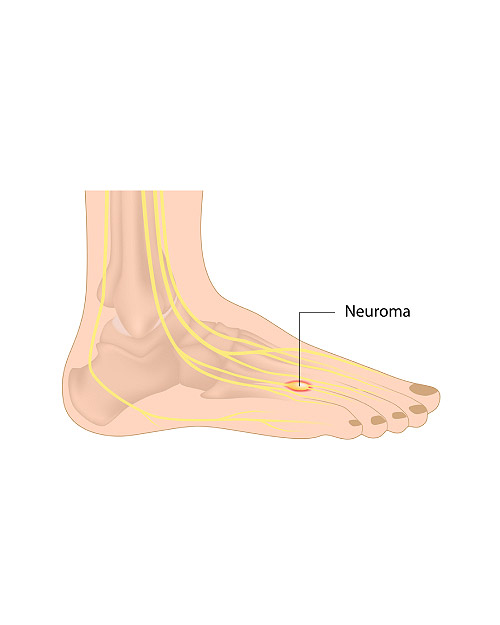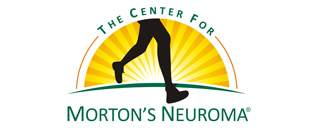Home > Conditions Treated > Morton’s neuroma

Morton’s neuroma develops when a nerve in the foot swells because of chronic irritation, compression and poor blood supply. You may feel a sharp, burning pain in the ball of your foot, especially in the area between the third and fourth toes, where Morton’s neuroma most often occurs. Other symptoms may include tingling and numbness in your toes, sharp or burning pain from the ball of the foot to your toes and pain while standing or walking. While benign, it can be very painful and debilitating.
When you have Morton’s neuroma symptoms, a simple task such as walking can become unbearable.
Morton’s Neuroma is more likely to occur in women who wear high-heeled shoes for long periods. Athletes are also prone to having Morton’s neuroma if their sport involves high-impact activities with intense “stop-start” movements. Some sports require players to wear tight, narrow shoes that put pressure on the toes as well.

The Center for Morton’s Neuroma treats more Morton’s neuroma patients than any other place in the country. They are the only center that we know of to provide a wide spectrum of treatments for Morton’s neuroma so they can offer you the most appropriate non-surgical procedure to cure your Morton’s neuroma. The services they provide range from simple medication to ultrasound guided ablation procedures to, if necessary, surgery as a last resort.
Care must be taken in diagnosing Morton’s neuroma. In some cases, nerve pathology of the entire foot can be missed because the examiner mistakenly thinks that the problem is a Morton’s neuroma. For this reason, it is important to see an experienced practitioner, and they have to take a careful history followed by an in-depth physical exam. Morton’s neuroma is frequently present, if it is painful to presses on the space between the third and fourth toes to elicit a Mulder’s sign. Oftentimes, people with foot neuroma will hear an audible click after the podiatrist does this test.
The gold standard for diagnosing Morton’s neuroma is with a diagnostic local anesthetic injection. We do diagnostic injections on nearly all of our patients to make or confirm the diagnosis of Morton’s neuroma. It also gives us a good indication as to whether our ablation procedures will be successful. A local anesthetic such as lidocaine is injected with ultrasound guidance into the neuroma. If the pain is eliminated by the local anesthetic injection blocking the nerve, then a diagnosis of Morton’s neuroma is highly likely. However, if the block fails to relieve the pain, then it is more likely that the pain is caused by a different condition.
Our philosophy is to treat your Morton’s neuroma with the most appropriate non-surgical treatment for you and only resort to surgery as a very last option. Ultrasound guided non-surgical procedures are the treatment of choice to cure Morton’s neuroma.
This minimally invasive treatment makes use of high-frequency radio waves which target nerves affected by Morton’s Neuroma. The heat emitted by these radio waves breaks down proteins which prevents nerve fibers from transmitting pain. In addition, this procedure stimulates the creation of new blood vessels which promotes healing.
Unlike Radio Frequency Ablation which uses heat, Cryotherapy Ablation makes use of extremely cold temperatures. This procedure is done by using liquid nitrogen or argon gas in order to freeze and destroy tissues affected by Morton’s Neuroma.
This treatment involves injecting a neurolytic agent like concentrated alcohol into the affected tissue. This eliminates or at least significantly decreases the ability of the nerves to transmit pain signals, thereby causing pain relief from Morton’s neuroma.
If done by a specialist physician who is experienced in doing these procedures and done under ultrasound guidance, the three procedures should be equally as effective, with success rates above 85%.
Platelet Rich Plasma Injections. This is nearly always combined with an ablation to increase the effectiveness of the ablation. Platelet Rich Plasma Injections method involves harnessing your body’s natural ability to regenerate itself in order to promote the healing of injured tendons, ligaments, muscles and joints. Platelet Rich Plasma Injections are Taking a sample of your own blood, then centrifuging it to concentrate the platelets. After this, the activated platelets are then administered into the damaged tissues.
It is important to avoid high heels or tight shoes and wear wider shoes with lower heels to let the bones in the foot relax and heal. Orthoses or custom shoe inserts can help relieve stress on one area of the foot by distributing force evenly and we recommend these after ablation treatment.
Although Orthobiologic Cell Therapy is considered by some people to be experimental, various research studies show that some marrow aspirate concentrate and platelet rich plasma injections may provide excellent relief from joint and musculoskeletal pain and ongoing inflammation.
600 Worcester Rd, Ste 301,
Framingham, MA 01702
This information is for educational purposes only and is NOT intended to replace the care or advice given by your physician. Always seek the advice of your physician or other qualified health provider before starting any new treatment or with any questions you may have regarding a medical condition. For more information see our Medical Disclaimer.